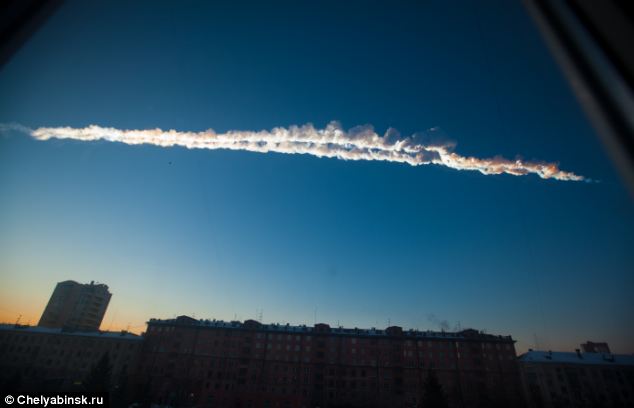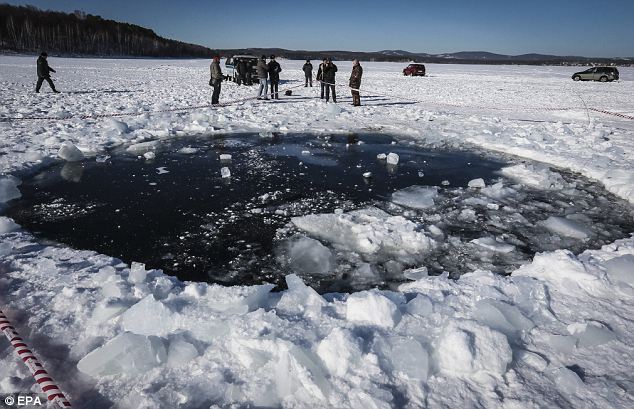
The rock created a 50-foot hole in a frozen lake near Chelyabinsk
Scientists have analysed more than 53 tiny fragments of the meteor
It is thought to have been part of a large Apollo asteroid called 2011 EO40
The meteor fireball that crashed into Russia in February was part of a 656-foot wide asteroid called 2011 EO40.
Spanish astrophysicists analysed fragments of the meteor that were scattered across the Russian town of Chelyabinsk, where the meteor landed, and claim it came from the large Apollo asteroid that regularly crosses passed Earth as it orbits the sun.
They added that the piece may have broken off because of the stress caused by the gravitaional pull of the planets and the sun, or could have been caused by the asteroid hitting into something else during its orbit.
This caused the fragment to separate off and plummet towards Earth.
The meteor fireball, also known as a superbolide, was seen over Chelyabinsk in the south of the country near the border of Kazakhstan and around 900 miles east of Moscow.
It exploded over Russia's Ural Mountains and is the biggest space rock to have hit earth in more than a century.
The 10,000 tonne rock, measuring around 55 feet in diameter, created a huge hole in a frozen lake when it crashed into the ground.

Nasa scientists at the time said the shockwave caused by the crash was greater than 30 Hiroshima nuclear bombs and was so powerful it travelled twice around the world.
The Russian meteor hit the Earth just hours before an asteroid called 2012 DA14 was spotted nearby but the two incidents were not found to be related.
Professor Carlos de la Fuente Marcos and his brother Raul from the University of Madrid identified 20 possible sources from a cluster of asteroids dubbed Chelyabinsk asteroid family.
They told The Telegraph: 'The most probable parent body for the Chelyabinsk superbolide is 2011 EO40. Under such conditions, the cluster cannot be older than about 20,000 - 40,000 years.'
However, the only way to confirm this theory, claims Marcos, would be to go into space and take samples of the 2011 EO40 asteroid.
German scientists are also set to publish finding later this year that claim the meteor was made of a stony material called chondrite breccias. Most asteroids are made up of boulders, dust and ice.
Professor Carlos de la Fuente Marcos added that another similar incident is 'unlikely' but smaller fragments might crash to Earth as the asteroid continues its orbit.
The meteor caused widespread property damage in Chelyabinsk city, with health officials saying that 46 of the injured remain hospitalised.
The debris narrowly missed a direct and devastating hit on the industrial city which has a population of 1.13 million but spread panic through its streets as the sky above lit up with a blinding flash.
Paul Chodas of NASA's Near-Earth Object Program Office said at the time: 'We would expect an event of this magnitude to occur once every 100 years.'
He told the Wall Street Journal: 'When you have a fireball of this size we would expect a large number of meteorites to reach the surface and in this case there were probably some large ones.'
Viktor Grokhovsky, who led the expedition from Urals Federal University, said that 53 fragments of the meteor had been plucked from the ice-covered Chebarkul Lake.
The local governor estimated the damage at 1 billion rubles (£21.5million) and said he hopes the federal government will provide at least half that amount.
Lidiya Rykhlova, head of the astronomy department at the Moscow-based Institute for Space Research, said experts have drafted a program that envisages building powerful telescopes, including space-based ones, to warn against potentially dangerous asteroids, comets and other threats.
As it raced through the sky, the 50-foot wide chunk of space rock compressed the air ahead of it, creating the enormous temperatures that meant it exploded in a fireball somewhere between 18 and 32 miles above the ground at around 9.20am local time on 19 February.
Although some debris fell to earth, 'whipping up a pillar of ice, water and steam' and creating a 20-foot-wide crater, the damage in nearby towns was actually caused by shockwaves created by the meteor breaking the sound barrier and then exploding.
Collectors from around the world will be keen to get hold of a piece of the meteor. Film director Steven Spielberg is a noted collector. In October a 9in piece of the Seymchan meteorite found in Siberia in 1960 sold in New York for $43,750 (£28,200).
Astronomers have also revealed that the meteor could have hit UK cities if it had hit at a slightly different time of day.



If like our Moon, it was orbiting the Earth (e.g. periodically), it would still be doing so.
More accurately, the asteroid's path (orbit around the Sun) crossed near to the Earth's orbit around the Sun